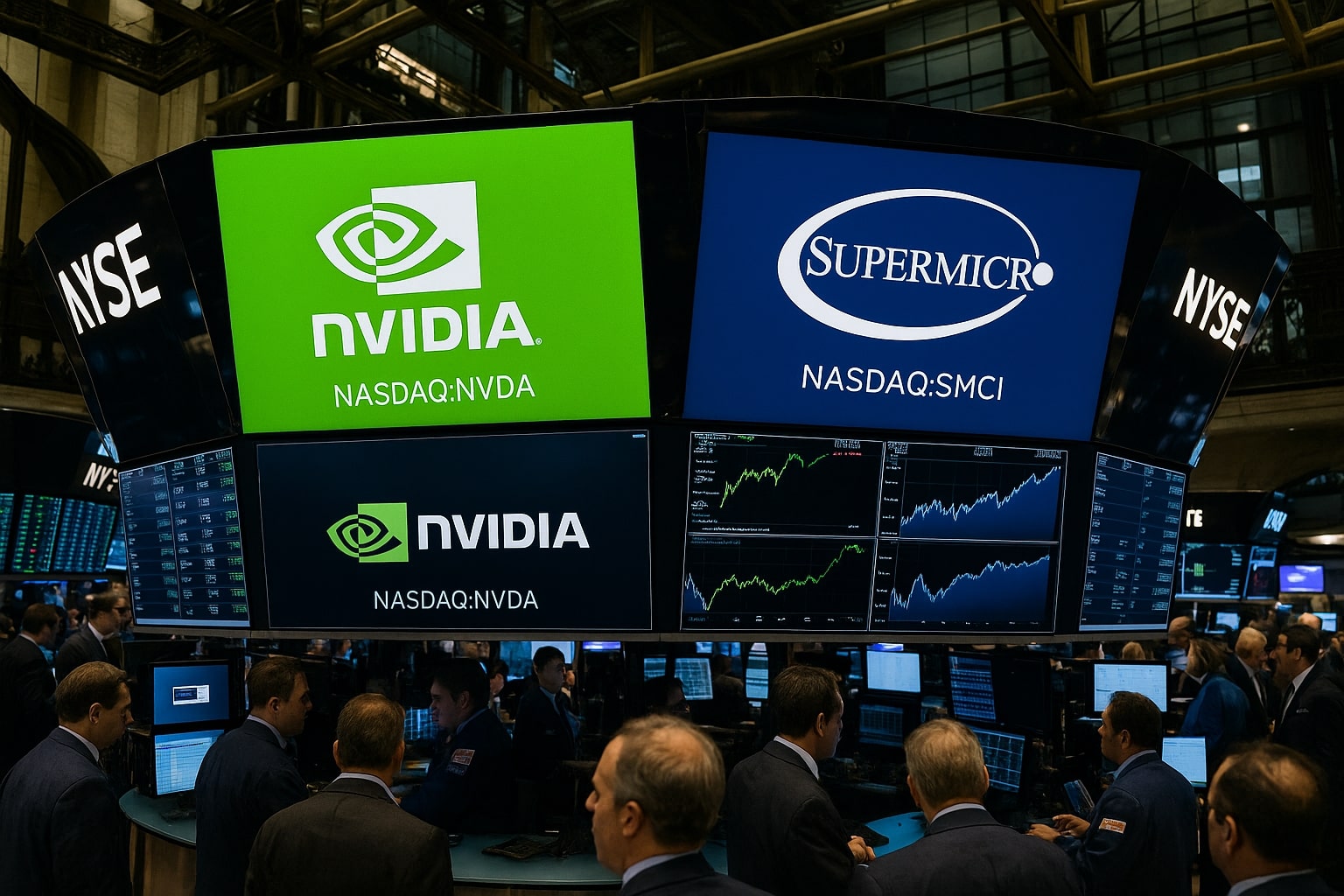
NVIDIA Stock vs. Super Micro Stock: NVDA at $174 Dominates AI While SMCI Sinks to $41
NVIDIA (NVDA) Maintains AI Leadership as Super Micro (SMCI) Faces Crumbling Confidence | That's TradingNEWS
NVIDIA vs. Super Micro Computer: Two AI Stocks, Two Very Different Stories
NVIDIA (NASDAQ:NVDA) Still Dictates the AI Trade
NVIDIA NASDAQ:NVDA continues to operate on a completely different plane from the rest of the AI hardware universe. The company closed its most recent quarter with $46.7 billion in revenue, a 55.6% year-over-year jump, and an eye-popping $26.4 billion in net income. Margins north of 70% show that the firm is not just growing—it’s monetizing its dominance at levels unheard of in semiconductors. Shares trade around $174, down from the recent peak at $184.48, but the market still assigns the company a staggering $4.24 trillion valuation. At nearly 50x trailing earnings and 40x forward earnings, investors are clearly paying for more than hype—they’re paying for a business that has become the indispensable supplier to hyperscalers, sovereign governments, and enterprises racing to build AI infrastructure.
Even with export bans cutting China sales almost in half, NVIDIA still pulled in $650 million from H20 chips sold outside China. Looking ahead, management guided for $54 billion in Q3 revenue, above the Street’s $52 billion estimate, and that figure doesn’t yet include any upside from a possible resumption of China H20 shipments. With $56 billion in cash, a $60 billion buyback authorization, and insider transactions here showing only modest selling, NVIDIA is still the anchor stock in AI.
Super Micro Computer (NASDAQ:SMCI) Is in a Fight to Stay Relevant
Super Micro NASDAQ:SMCI tells a very different story. Shares sit at $41.54, collapsing nearly 30% in August after a messy combination of missed earnings, slashed guidance, and governance questions. The latest quarter came in at $5.76 billion in revenue, up just 8.5% year-over-year, while earnings per share dropped 35% to $0.41. Profit margins barely cracked 5%, compared with NVIDIA’s 52% net margin. The company was forced to cut its fiscal 2026 revenue target from $40 billion to “at least $33 billion”, immediately raising doubts about whether AI server demand can justify its previous hype.
Worse, SMCI admitted in its SEC filing that it has “material weaknesses” in financial reporting controls. For a company already under the microscope, this disclosure sent investors fleeing. Its market cap has shriveled to $24.7 billion, down from nearly $48 billion at its peak, and short interest has surged to 26% of the float, signaling that many traders are betting the pain isn’t over.
Insider activity paints another worrying picture: executives have been aggressively selling shares, with details visible here. This is a sharp contrast to NVIDIA, where management still behaves like it’s playing offense.
Two Valuations, Two Realities
Valuation underscores just how far apart these companies are. NVIDIA trades at 26x sales and 40x forward earnings, expensive by any normal standard but supported by unmatched free cash flow—$52.4 billion in the last twelve months—and returns on equity above 100%. SMCI looks cheap on the surface at just 1.2x sales and 15.8x forward earnings, but those multiples reflect thin margins, shaky execution, and governance risks rather than real value. Analysts see NVIDIA’s EPS growing from $4.48 in 2026 to $7.42 in 2028, a compound annual rate of nearly 30%. For SMCI, consensus expects EPS of $2.61 in 2026 rising to $3.49 in 2027, growth that’s decent but nowhere near NVIDIA’s scale and with far higher execution risk.
Institutional flows confirm the divide: 69% of NVDA shares are institutionally owned, compared with 52% for SMCI. Meanwhile, NVIDIA’s short interest is under 1%, while SMCI’s sits at 26% of float—a level that screams investor skepticism.
Market Position and Competitive Pressures
NVIDIA is more than just chips—it has built an ecosystem through CUDA, Omniverse, and DGX platforms that makes it prohibitively expensive for customers to leave. This is why its gross margins stay north of 70%, even as competitors like AMD and Intel fight for scraps. SMCI, by contrast, is locked in a commodity war against Dell, HPE, and now even Alibaba’s AI server initiatives. Its promise lies in its DCBBS technology, which claims 40% power savings and 20% lower total cost of ownership. If scaled, this could help rebuild margins, but the market has grown skeptical of execution after repeated guidance resets.
Stock Performance and Technicals
NVIDIA’s stock remains a momentum leader. It trades well above its 200-day moving average at $138.75, with support building near $160 and resistance capped at the all-time high of $184.48. SMCI, however, has broken below $42 support, with the next real floor around $31. That technical breakdown suggests selling pressure may continue unless management regains investor trust. Over the past year, NVDA has rallied 61%, while SMCI has slipped nearly 6%, underscoring just how quickly investor sentiment can diverge even within the same AI narrative.
Bottom Line: Stability vs. Speculation
Both companies ride the AI wave, but only one has proven it can deliver consistent, profitable growth. NVIDIA is expensive, but its fundamentals justify the premium. Super Micro, once hailed as a dark horse, has stumbled into credibility and governance issues at the exact moment it needed to prove scale. The numbers tell the story clearly: $174 per share and $4.2 trillion in value for NVIDIA versus $41 per share and $25 billion for SMCI. Same sector, completely different leagues.
That's TradingNEWS
Read More
-
AbbVie Stock Price Forecast - ABBV at $229 Turns the Humira Cliff Into a 2026 Growth Engine
02.01.2026 · TradingNEWS ArchiveStocks
-
XRP Price Forecast - XRP-USD Nears $2 as $1.80 Support and Shrinking Supply Point to $2.60 Target
02.01.2026 · TradingNEWS ArchiveCrypto
-
Oil Price Forecast - Oil Slide Into 2026: WTI Stuck at $57, Brent at $60
02.01.2026 · TradingNEWS ArchiveCommodities
-
Stock Market Today: Nasdaq Hits 23,467 as Nvidia (NVDA), Micron (MU) and Baidu (BIDU) Drive AI Surge
02.01.2026 · TradingNEWS ArchiveMarkets
-
GBP/USD Price Forecast: Pound Holds 1.3450 as Fed–BoE Split Keeps Bulls Aiming at 1.37
02.01.2026 · TradingNEWS ArchiveForex


















